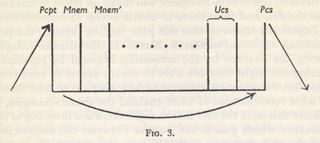Over at the Paris Review, I synthesize my quack science-fiction criticism and my recent reading of Freud’s Interpretation of Dreams into a blog post about Christopher Nolan’s new movie Inception.
Left on the cutting-room floor was a comparison between the movie’s diagram of dreaming and Freud’s—too geeky even for the Paris Review, and offered as an outtake here:
As part of a recruiting pitch, the dream invader Cobb, played by Leonardo DiCaprio, draws the following diagram in Christopher Nolan’s new movie Inception:
While the mind is dreaming, Cobb claims, it creates a world and experiences it simultaneously, and the tightness of the feedback loop is what makes dreams so potent and intoxicating.
For comparison, here is the diagram that Sigmund Freud drew to explain dreaming:
Read from left to right, Freud’s diagram represents waking life. At the far left, stimuli (sounds, images, tastes, etc.) enter the human mind through the perceptual system, which Freud labels “Pcpt.” Once inside the mind, the perceptions leave a memory trace, labeled “Mnem”—a record of the sensation and of associations between them. Over the course of a lifetime, a person has many experiences and therefore accumulates many layers of memories and associations. Freud suggests these layers by adding a level “Mnem-prime” after “Mnem” and then adding ellipsis dots after that. These memories are for the most part unconscious, though many of them can be made conscious. Also unconscious (“Ucs”) are many of a person’s wishes and fears, some of the most powerful of which are the oldest, which derive from memory traces laid down in childhood, when a person is most impressionable. In responding to a new experience, a person may be motivated by his unconscious but only takes action through his preconscious mind (“Pcs”). It’s the preconscious that brings memories and associations into consciousness and controls motor activity—the downward arrow exiting the diagram on the far right.
In waking life, excitation moves from left to right, in the direction of the arrow that Freud drew along the bottom of his diagram. But in dreams, Freud suggests, excitation moves backward—from right to left. Dreams begin as wishes in the unconscious and move backward through memory until at last they reach the perceptual system, which they stimulate into hallucination.
Freud’s diagram seems at first to lack a loop like the one in Cobb’s, but in fact it does contain one. That’s because the outside world appears both at the far left of Freud’s diagram and at the far right. The world is both the source of sensation and the domain upon which a person acts. In Freud’s understanding, a dream breaks the loop through the outer world, sending excitation into a short circuit that never leaves the mind. Whereas in waking life a person acts upon the world in order to attain remembered pleasures, a dreamer merely hallucinates the satisfaction of his wishes. Freud thinks that infants for a while attempt the same psychic shortcut even while awake. But “the bitter experience of life,” Freud drily notes, forces a child to concede in time that an imaginary bottle of milk is not as good as a real one.



Glad you posted the outtake, Caleb. This is more about sleep than dreaming, but it might be of interest:
http://meanjin.com.au/editions/volume-69-number-2-2010/article/on-the-invisibility-of-sleep/
Thanks, Liz!
Caleb: My 19 year old son saw Inception last weekend with a large group of friends and said it was the best movie he's ever seen. That sort of enthusiasm shouldn't be ignored, but I've not seen it yet. Your "review" is astonishing – I think Pauline Kael has just shifted positions in her sleep. For Borges, the dream was, perhaps, a parable, and there's some suggestion that dreams run forward in time, but that we've lost the skill to read the future, or have not quite developed the skill yet. I hope you move on to "Civilization and Its Discontents." It may also provide a reading of "Inception." Anyway, great review. And nice to see you over at Paris Review.